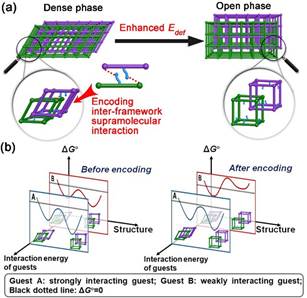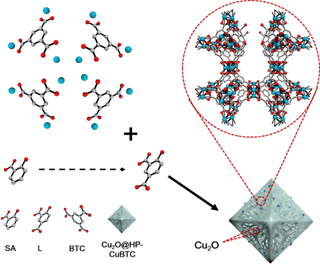Molecular recognition plays a key role in numerous biological and chemical processes. Recently, inspired by various biomolecules (for example, proteins) with high degrees of structural freedom for precise molecular recognition, soft porous coordination polymers (PCPs) exhibiting guest‐triggered structural transformations, also known as Metal-Organic Frameworks (MOFs), have attracted significant attention. Numerous studies on engineering the structural flexibility of PCPs have been conducted with the aid of several methods involved framework design, ligand modification, guest‐occupancy control, and crystal downsizing. Nonetheless, until recently, the focus has been on investigating the structural flexibility by utilizing crystallographic diffraction and sorption profiles, and few reports on material design from energy perspectives are available.

Recently, the team of Professor Li Fengting from the College of Environmental Science and Engineering of our university, cooperated with the team of Professor Susumu Kitagawa of Kyoto University who is also academician of The Japanese Bachelor Institute. For the first time a new strategy of controlling the softy of PCP materials was put forward, the hydrogen bonding into the flexible PCP material skeleton with interpenetration structure was successfully introduced, and the deformation energy required by the change of material structure was fine-regulated by the hydrogen-bonding interaction, thus changing the potential energy curve of the material when it adsorbs specific guest molecules. Compared with the smaller size and lower toxicity of dichloromethane, the flexible regulated MOF material can realize selective "gate‐opening" adsorption on the larger size and higher toxicity of chloroform. This work closely combines theoretical chemistry and experimental chemistry, and provides a new research idea for the design of flexible porous materials. Gu Yifan, a postdoctoral fellow of Professor Li Fengting's research group, is the first author of the paper published in the Angew. Chem. Int. Ed.
Hierarchical porosity and the exposure of sufficient active sites are primary features for robust frameworks designed towards efficient adsorption, especially that of large molecules. Feng Tao, a doctoral student of the research group, made the latest progress in constructing multistage pore CuBTC (HKUST-1 is a metal organic skeleton (MOF), which is composed of 1,3, 5-benzoic acid between copper nodes and them for desulfurization research, publishing a paper entitled "Feasible would transformation strategy forward Cu2O nanoparticles immobilized hierarchical CuBTC creation for adsorption desulfurization" in the journal . in J. MATER. CHEM. A, they introduced a new strategy called linker transformation method, which could construct mesoporous and Cu2O nanoparticles in CuBTC simultaneously. Relying on this method, they constructed hierarchically porous CuBTC with tunable pore size distribution, and the crystallinity and stability were maintained after adding transformed linkers. Furthermore, linker transformation promoted the formation of Cu2O nanoparticles immobilized in the open framework of CuBTC, which exhibited more active sites for sulfur compounds. The hierarchical porous structure enabled easy diffusion of large-sized sulfur compounds, while the small Cu2O nanoparticles were highly dispersed, which led to highly enhanced desulfurization adsorption performance. The strategy presented here may provide new insights for designing more abundant MOF structures and further expanding their application range.

Construction of hierarchical pore MOFs and organic desulfurization principle
Recently, Professor Li Fengting's team has carried out a lot of cutting-edge work in the design and preparation of porous materials for environmental functions, which could be used for the identification and separation of water weight pollutants, clean energy purification, and ultrafine detection of water pollutants. The above researches have been supported by the National Natural Science Foundation of China, the International Science and Technology Cooperation Program of the Ministry of Science and Technology, as well as the International Science and Technology Cooperation Program between the governments of Shanghai municipality.
Related Links:
1. Gu, Y., Zheng, J. J., Otake, K. I., Sugimoto, K., Hosono, N., Sakaki, S., Li, F. & Kitagawa, S, Angew. Chem. Int. Ed, 2020(https://doi.org/10.1002/anie.202003186)。
2. Feng, T., Wang, Y., Wu, Y. N., Kabtamu, D. M., Laszlo, K., & Li, F., J. Mater. Chem. A, 2020, 8, 8678 - 8683(https://doi.org/10.1039/c9ta13505g)。
3. Li, J., Yu, C., Wu, Y. N., Zhu, Y., Xu, J., Wang, Y. & Li, F, Environ. Int., 2019, 125, 135-141(https://doi.org/10.1016/j.envint.2019.01.033)。
4. Xu, J., Yu, C., Feng, T., Liu, M., Li, F., Wang, Y., & Xu, J., Nanoscale, 2019, 10, 19390-19398(https://doi.org/10.1039/c8nr05098h)。